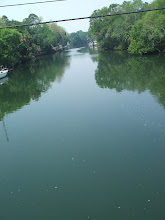Here's a few snippets about Wal-Mart's Disaster Preparedness/Response that I found on the web. Google Walmart Way Disaster Preparedness for the full article.
"...judging from the poor response from the federal government and the comparatively effective response from private retailers after Hurricane Katrina," economist Steven Horwitz, Ph.D. says, “Big-box retailers such as Wal-Mart were extraordinarily successful in providing help to damaged communities in the days, weeks, and months after the storm.”
"The assumption behind centralized government (especially federal) solutions, such as financing and directing both the response to and recovery from natural disasters is the belief that 'the private sector’s profit motive would thwart the charitable impulses generally regarded as essential for effective relief,' says Dr. Horwitz. However, 'the private sector’s involvement in the response to Hurricane Katrina…has provided strong reasons to be skeptical of this argument,' he cautions.
Major media focused on the failures of the Federal Emergency Management Agency (FEMA), while the successes of the private sector received little publicity following Katrina. However, “During the Katrina relief efforts, the more successful organizations were those that had the right incentives to respond well and could tap into the local information necessary to know what that response should be.”
An example is Wal-Mart, the world’s largest retailer. Wal-Mart “arrived in the New Orleans area long before FEMA and had the supplies that the community needed,” writes Horwitz. “Both President Aaron Broussard and Sheriff Harry Lee of Jefferson Parish in suburban New Orleans lauded Wal-Mart’s work. In an appearance on Meet the Press, Broussard noted that Wal-Mart had delivered three trailers of water only to be turned back by FEMA and quoted Lee in saying, “if [the] American government would have responded like Wal-Mart has responded, we wouldn’t be in this crisis.”
Phillip Capitano, mayor of the New Orleans suburb of Kenner, said, “The only lifeline in Kenner was the Wal-Mart stores. We didn’t have looting on a mass scale because Wal-Mart showed up with food and water so our people could survive.”
One of the reasons Walmart's response was quick and efficient was its utilization of their emergency management department at the Bentonville, Arkansas, headquarters. “The department’s planning section produced detailed emergency procedures, including charts that let store managers and employees flip quickly to advice on problems ranging from electrical outages to animal infestations. A preparedness group trained managers, response teams, and associates in executing the plans they were given.”
"Wal-Mart also founded “Wal-Mart Alarm Central” where six to eight people sit at a bank of computers monitoring fire and burglar alarms at all 3,218 Wal-Mart stores and 555 Sam’s Clubs nationwide." The group also watches CNN, Fox News, and the Weather Channel for news that could affect store operations.
Alarm Central’s most high-profile function is as the emergency operations center (EOC), where it “oversees coordination, response, and recovery for business disruptions ranging from tornadoes to terrorism to epidemics.”
“The EOC,” according to Jackson, “operate[s] under three levels of activation. Jackson and his team handle small events from their desks. If from five to 50 Wal-Marts or Sam’s Clubs [are] likely to be affected—for example, by wildfires or a small hurricane—Jackson call[s] a Level Two alert and ‘activate[s]’ the EOC, a stark, rectangular room in a building on Wal-Mart’s Home Office campus filled with rows of desks separated by low partitions. A Level Two response typically involve[s] from six to a dozen senior representatives from functional areas such as emergency merchandise, transportation, logistics, and corporate giving who would come to the EOC and closely coordinate the response along with Jackson’s team. A Level Three, a large hurricane or other major event, could draw in as many as 60 people, including representatives of 35-40 different departments.”
Seems to me every community and buisness could take some tips from these guys.
Subscribe to:
Post Comments (Atom)





No comments:
Post a Comment